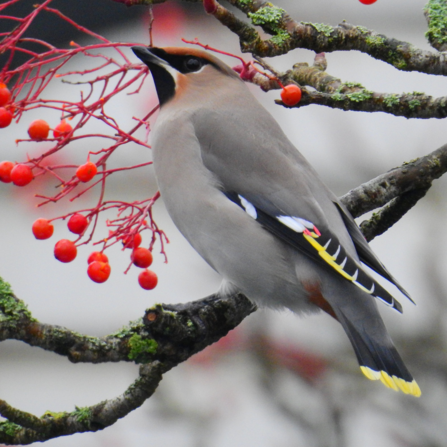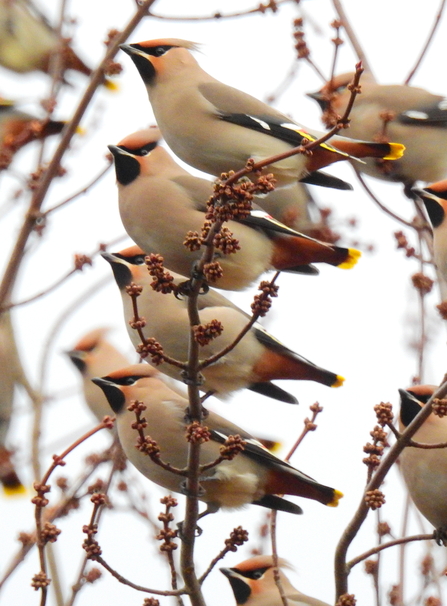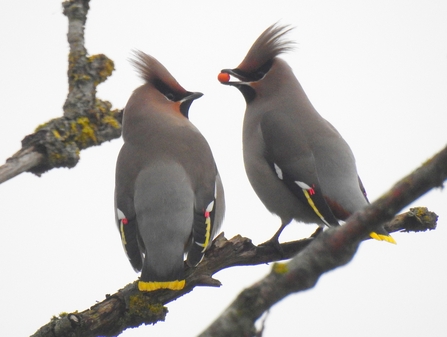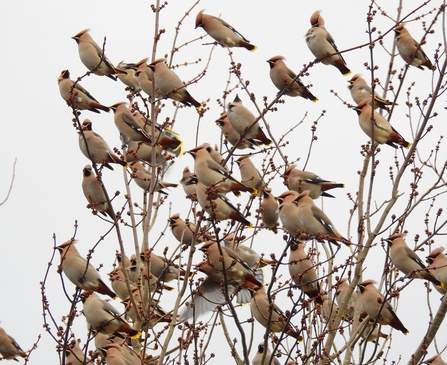In Lancashire, we are enamoured with a little feathered phenomenon called waxwing irruptions. Across the North West, our valued members and followers have been sharing their sightings and stunning photos of this wandering winter visitor with us.
The Wonder of Waxwings
Waxwingspan. A bohemian waxwing in Lancaster
Photo by Greg Smith

A wonderful waxwing feeding on winter berries in Burnley town centre
Photo by Jen Coates
What are waxwings?
Waxwings (Bombycilla garrulus) are sociable, resilient birds of the passerine order. They do not breed in the UK but grace us with a visit over winter. They arrive in huge flocks and can turn up anywhere- from town centres and domestic gardens, to local parks and supermarket carparks. These flocks are called ‘irruptions’, a name befitting of their sudden appearance in droves. For some of our followers and keen birders, waxwings’ nomadic wandering and irregular irruptions are somewhat of a phenomenon, inspiring a treasure hunt to spot them before they disappear. Happily, they are classified as 'green conservation' status. The seeds of fascination for these birds are also sown by the fact that waxwings are simply stunning. With a tropical mix of graceful greys, browns and apricots with pops of sunshine yellow and red, they are a distinctive, exotic sight.

Proud plumage. Waxwings in Skipton
Photo by Jen Coates
Why are they called waxwings?
Waxwings are so-called because of red patches of waxy secretions on their secondary wing feathers. It is not fully understood why they have these waxy spots, but it is thought by ornithologists that they serve the purpose of sexual selection; to attract mates.
Where do they come from?
Like all wildlife, waxwings are particularly sensitive to a changing climate which affects their available food resources. Waxwings winter with us when the fruits and crops fail in Scandinavia and other areas of Northern Europe.
A bohemian waxwing showing of it's striking tail feathers
Photo by Greg Smith
How to identify a waxwing
There are 3 different types of waxwings; Cedar, Bohemian and Japanese. Our main wandering waxwing is the Bohemian beauty, and occassionally the rarer Cedar variety. Bohemians and Cedars are similar in appearance, both with prominent plumage and a striking black facemask. However there are some distinguishing features. Here's how to tell a Bohemian from a Cedar:
Body: Bohemian waxwings have a glossy grey body and a peach blush on their facemask, unlike Cedars who sport warm browns with a pale yellow belly.
Tail: The Bohemian waxwing has a streak of russet-red feathers on its undertail, in contrast to Cedar's which are white, ending in a sunshine yellow tail tip which looks like it's been dipped in paint.
Wings: A Bohemian's wings are more brightly decorated than the Cedar, which is still handsomely marked. Spots and streaks of white, yellow and red on the Bohemian give it away. The scarlet waxy spots are not found on all birds, and tend to appear with age in both the Bohemian and Cedar.
Size: Although Bohemian waxwings are a tad smaller than a starling, they are still significantly bigger than Cedar waxwings, and this is more obvious when they flock together in flight or settle in groups on tree branches. Bohemians can be up to twice the body weight of a Cedar!

Birds of a feather dine together
Photo by Jen Coates
Where have waxwings been spotted this winter?
Our valued members and followers have been keeping us up to date on their waxwing sightings across Lancashire (and Yorkshire!). Here are some of the hotspots they have appeared this winter:
- Ashton, Preston
- Arnside and Caton, Lancashire
- Garstang/Wyre
- Eccleston near Chorley
- Burnley town centre
- Lancaster
- North Manchester
- Weatherby, Yorkshire
- Skipton, Yorkshire
Waxwingspan. A bohemian waxwing in Lancaster
Photo by Greg Smith
When is the best time of year to see waxwings?
Waxwings will typically visit the British Isles between October and April and are most active in the morning and late afternoon. They commonly turn up in the North and East of the UK.
Why do they come to the UK for such a short time?
Waxwings use our country as a pit stop, or service station, along their migration journey. They are opportunists in the fact that they will take a break anywhere there are fruit-rich foliage and an abundance of berries. Waxwings come to us to take advantage of our resources when those of Northern Europe are low, which is why some years their number swells from hundreds to thousands, popping up anywhere from supermarket carparks, local parks, and domestic back gardens. They are a fickle friend, however, as they are not loyal to any particular flyway as other migratory birds are, and can often take up to 6 months to complete their journey due to these frequent stop-offs to dine in droves on berry bushes. This is why they are often referred to as 'wanderers' or 'nomads', which only increases our fascination with spotting them!
Hanging around in Lancaster
Photo by Greg Smith
What do waxwings eat?
Waxwings are frugivores; one of our few strictly berry-eating birds. They are particularly fond of Rowan and Hawthorn berries, but will be pushed to eat insects and other fruits when resources are scarce, or when the summer breeding season approaches. They are also particular about which colour of berries they eat; choosing red and orange berries over yellow and white ones. One of their quirks that undoubtedly endears them to British bird-lovers is that they are sugar fiends, preferring berries on the cusp of fermentation, meaning that they often fall into a drunken furore when they feast. Waxwings can berry-binge up to double their own body weight in a day!

Irrupting into Burnley town centre, Lancashire
Photo by Jen Coates
What does a waxwing sound like?
Waxwings have a pleasant, rolling trill call, like the tinkling of a bell. You can listen to the charming waxwing birdcall from RSPB’s identification page here
How can I keep up with waxwing sightings in Lancashire?
Have you spotted any of our winter waxwings? Share your sightings with us on social media!
Instagram @lancashirewildlifetrust
X (formerly Twitter) @Lancswildlife
Facebook @lancashirewildlifetrust
If you love waxwings, we'd also recommend following @WaxwingsUK on X (formerly Twitter)


